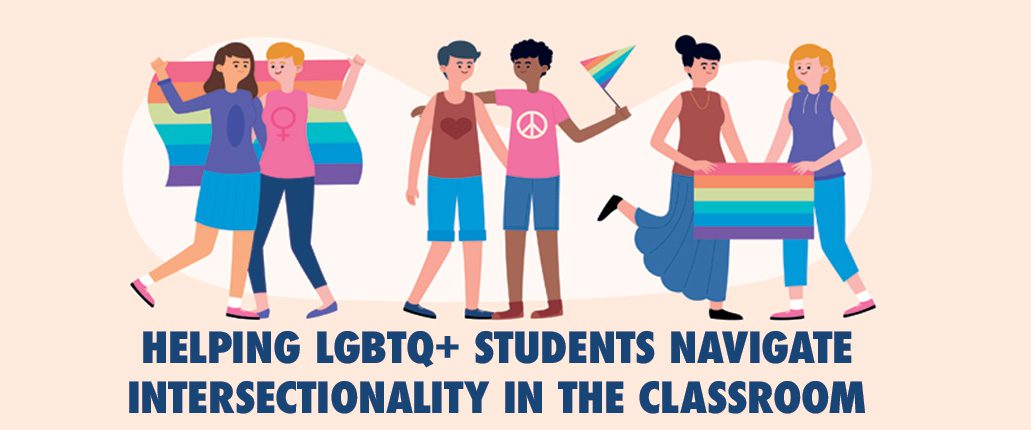
Helping LGBTQ+ Students Navigate Intersectionality in the Classroom
As the school year kicks off, parents and educators have a renewed opportunity to support LGBTQ students as they navigate the complexities of their identities. For LGBTQ students, the school environment can be a place of both growth and challenges, especially when intersecting identities—such as race, gender, socioeconomic status, and disability—come into play. Recognizing and addressing these intersecting identities is essential in fostering a supportive, inclusive, and equitable environment where every student can thrive.
Here are some strategies for parents and educators to help LGBTQ students navigate intersectionality in the classroom:
Understanding Intersectionality
Intersectionality, a term coined by scholar Kimberlé Crenshaw in 1989, refers to how various aspects of a person’s identity (such as race, gender, sexuality, disability, and religion) intersect and interact with one another. This concept is essential in understanding that students do not experience life through just one lens but through multiple, interrelated identities. For LGBTQ students, these intersections can shape their experiences in unique and sometimes challenging ways.
Here are some strategies for parents and educators to help LGBTQ students navigate intersectionality in the classroom:
1. Create Safe and Affirming Spaces
One of the most crucial steps is ensuring that LGBTQ students feel safe and accepted in their learning environment. This includes establishing classrooms as safe spaces where students can express their identities without fear of discrimination or harassment. Educators can set the tone by clearly stating their commitment to inclusivity and by actively using inclusive language and materials that reflect diverse identities.
Parents can also advocate for these safe spaces by engaging with school administration and teachers, ensuring that the school’s policies and practices support LGBTQ students. This might include pushing for comprehensive anti-bullying policies that address LGBTQ issues and ensuring that gender-neutral bathrooms are available.
2. Educate Yourself and Others on Intersectionality
Intersectionality refers to how different aspects of a person’s identity—such as their race, gender, sexual orientation, and class—interact and affect their experiences. For LGBTQ students, these intersections can shape how they experience school, relationships, and self-identity.
Parents and educators must educate themselves on intersectionality to better understand the unique challenges faced by LGBTQ students who hold multiple marginalized identities. For example, a Black transgender student may face both racism and transphobia, creating a compounded experience of discrimination. By recognizing these intersecting identities, parents and educators can provide more nuanced and effective support.
3. Incorporate Diverse Perspectives into the Curriculum
One way to address intersectionality in the classroom is by ensuring that the curriculum reflects the diverse experiences of LGBTQ people from different backgrounds. This includes incorporating literature, history, and discussions that highlight LGBTQ figures of color, those with disabilities, and those from various socioeconomic backgrounds.
Educators should strive to include voices that reflect the diversity within the LGBTQ community, showing students that their identities and experiences are valid and valued. This approach not only benefits LGBTQ students but also enriches the entire classroom by broadening all students’ perspectives.
4. Encourage Open Dialogue and Active Listening
Fostering an environment where students feel comfortable discussing their identities is key. Encourage open dialogue in the classroom where students can share their experiences and listen to others. This helps to build empathy and understanding among students from different backgrounds.
Parents can support this at home by encouraging their children to talk about their day, including any challenges they may have faced related to their identity. Listening without judgment and offering unconditional support are vital in helping LGBTQ students feel understood and supported.
5. Support LGBTQ Student Organizations and Resources
Student organizations like Gay-Straight Alliances (GSAs) or other LGBTQ clubs provide essential peer support and advocacy within schools. These groups can be instrumental in creating a sense of community and belonging for LGBTQ students.
Parents and educators should support these organizations by helping to establish them if they don’t exist, promoting their activities, and encouraging students to participate. Additionally, making students aware of external resources, such as local LGBTQ centers or online communities, can provide additional support outside of school.
7. Be a Visible Ally
Visibility matters. When LGBTQ students see that their teachers, parents, and other adults in their lives are allies, it can provide a significant boost to their sense of belonging and self-worth. Displaying symbols of support, like pride flags or ally stickers, and attending LGBTQ events can signal to students that you are someone they can trust.
For parents, being a visible ally also means standing up for LGBTQ rights in your community, supporting inclusive policies at the school, and modeling acceptance and respect in all areas of life.
Understanding the Intersection of Neurodiverse and LGBTQ+ Identities
Kaleidoscope is committed to fostering an inclusive environment where neurodiverse LGBTQ+ individuals can explore and embrace all aspects of their identity without fear of misunderstanding or marginalization. Kaleidoscope acknowledges the unique challenges faced by those who are autistic or neurodiverse and who also identify as LGBTQ+. Understanding that the intersection of neurodiversity and LGBTQ+ identities can present additional complexities in areas such as social interaction, communication, and sensory processing, Kaleidoscope is well-versed in providing tailored support and resources. Interested in bringing a training to your school or organization about how to support students at this intersection? Reach out to us at kaleidoscope@thehelpgroup.org to schedule a consultation today!
Kaleidoscope also offers safe and affirming social events for our young people who are both neurodiverse and LGBTQ. Join us in Sherman Oaks on the evening of Friday September 13 for a FREE fun-filled evening of games to kick off the new school year at our Back-to-School Game Night! Whether you’re a pro at board games or just looking to unwind after a long day at school, this event is perfect for you! Pizza and snacks will be provided. Sign up HERE!
Wishing you a happy and healthy back to school season!
-The Kaleidoscope Team
